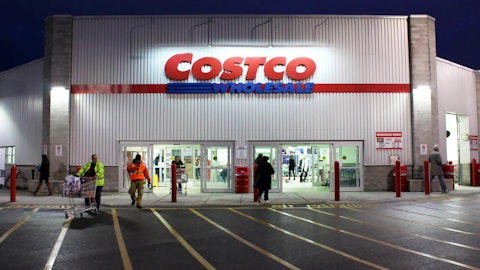Costco Wholesale Corporation (NASDAQ:COST) Q4 2023 Earnings Call Transcript September 26, 2023
Operator: Good day, everyone, and welcome to the Costco Wholesale Corporation Fourth Quarter and Fiscal Year 2023 Operating Results Call. Today’s call is being recorded. [Operator Instructions] I would now like to turn the conference over to Richard Galanti, CFO. Please go ahead, sir.
Richard Galanti: Thank you, Lisa, and good afternoon to everyone. I will start by stating that these discussions will include forward-looking statements within the meaning of the Private Securities Litigation Reform Act of 1995. These statements involve risks and uncertainties that may cause actual events, results and/or performance to differ materially from those indicated by such statements. The risks and uncertainties include, but are not limited to, those outlined in today’s call, as well as other risks identified from time to time in the Company’s public statements and reports filed with the SEC. Forward-looking statements speak only as of the date they are made, and the Company does not undertake to update these statements, except as required by law.

A customer in a warehouse aisles, browsing the wide range of branded and private-label products. Editorial photo for a financial news article. 8k. –ar 16:9
In today’s press release, we reported operating results for the fourth quarter of fiscal ’23, the 17 weeks ended September 3. These results and the figures presented today compare to last fiscal year’s 16-week fourth quarter. Reported net income for the 17-week fourth quarter came in at $2.16 billion or $4.86 per diluted share, compared to $1.868 billion or $4.20 per diluted share in the 16-week fourth quarter last year. In terms of sales, net sales for the 17-week fourth quarter were $77.43 billion, an increase of 9.4% from $70.76 billion in the 16-week fourth quarter last year. Comparable sales for the fourth quarter, and these figures are like-for-like number of weeks. In the U.S., reported was 0.2% comp. Excluding gas deflation and FX in the U.S., it would have been 3.1%.
Canada, reported was 1.8%, and excluding gas deflation and FX, 7.4%. Other International reported 5.5%, and again excluding gas deflation and FX, 4.4%. Also total Company reported 1.1% comp and 3.8% ex-gas deflation and FX. In terms of e-commerce, that came in at minus 0.8% reported and minus 0.6% excluding FX. Overall for the fiscal fourth quarter, food and sundries were relatively strong once again, with fresh foods right behind and with some offsets on some of the non-foods categories. In terms of Q4 comp sales metrics, traffic or shopping frequency increased 5.2% worldwide and 5.0% in the United States. Our average transaction or ticket was down 3.9% worldwide and down 4.5% in the U.S., impacted in large part from weakness in bigger ticket non-foods discretionary items, as well as the gas price deflation.
Foreign currencies relative to the U.S. dollar negatively impacted sales by approximately 0.3%, and gasoline price deflation negatively impacted sales by approximately 2.5%. Next on the income statement, membership fee income reported in the fourth quarter $1.509 billion or 1.95% of sales in the fourth quarter this fiscal year, compared to $1.327 billion or 1.88% in Q4 of last year, so $182 million increase or 13.7%. If you adjust for the extra week, the 13.7% would be roughly 7%, ex that extra week. Excluding FX and the extra week, the increase would have been around 7.5%. In terms of renewal rates at Q4 end, our U.S. and Canada renewal rates stood at 92.7%, which is up 0.1% from the 92.6% figure as of the end of Q3. The worldwide rate came in at 90.4%, down 0.1%, reflecting the impact of increasing penetration of memberships from international, which renew at a lower rate, in large part because of new openings internationally.
Our membership growth continues. We ended the fourth quarter with 71.0 million paid household members, up 7.9% versus a year ago, and 127.9 million cardholders, up 7.6%. That’s on the new openings over the past year of – just under 3% increase in new locations. At the fourth quarter end, we had 32.3 million paid executive memberships, an increase of 981,000 during the 17 weeks since Q3 end. The executive members now represent a little over 45% of our paid membership and approximately – paid members and approximately 73% of worldwide sales. Moving down the income statement, next is our gross margin. Our reported gross margin in the fourth quarter came in higher – came in at 10.60%, up 42 basis points from 10.18% a year ago, and that 42 basis points is up 16 basis points excluding gas deflation.
As I always ask you to jot down a few numbers with two columns, both reported and excluding gas deflation, the first line item would be core merchandise, on a reported basis, up 51 basis points year-over-year in the fourth quarter and ex gas deflation up 28 basis points. Ancillary and other businesses, minus 32 basis points and minus 38 basis points. 2% reward, minus 4 basis points and minus 2 basis points. LIFO, plus 27 basis points and plus 28 basis points. And if you total that up, on a reported basis, gross margin was up 42 basis points year-over-year and ex gas deflation, up 16 basis points. Starting with the core, again, up 51 basis points year-over-year, and ex deflation, up 28 basis points. In terms of core margin on their own sales, our core-on-core margins were higher by 35 basis points, with food and sundries and non-foods being up and fresh foods being down a little.
Ancillary and other business gross margin was lower by 32 basis points, and lower by 38 basis points ex gas. This decrease was driven almost entirely by gas due to the other components of ancillary and other, which would include pharmacy, e-comm, food court, business centers, optical, all those things on a relative basis year-over-year were in a couple of basis points plus or minus from a year earlier. 2% reward higher by 4 basis points and higher by 2 basis points, so a negative 2 basis points including gas deflation. That represents higher sales penetration coming from our executive members. And LIFO, of course, if you recall, last year in Q4, we had a $223 million pre-tax LIFO charge, while there was a small charge this year of $30 million on a year-over-year basis.
Of course, that showed the basis point improvement in margin. While we continued – we’ve continue to see sequential improvement in year-over-year inflation. I’ll talk about that a little later. We still had a small amount relative to the first day of the fiscal year, that’s a small charge in Q4. A couple of final comments on margins. First, we are of – we’re asked often recently about our inventory shrinkage results and whether it has dramatically increased in the past year versus historical shrink results. The answer is, no. In the past several years, our inventory shrink has increased by a couple of basis points, in part we believe due to the rollout of self-checkout. Over the past year, it has increased by less than 1 basis point more. So no, thankfully, not a big issue for us.
And second, the year-over-year margin improvement has in part been due to fewer markdowns due to better inventory positions this year than last. Our inventories overall are in good shape. Moving onto SG&A, our reported SG&A in the fourth quarter 8.96%, up from 8.53% a year earlier or up 43 basis points, and ex gas deflation up 21 basis points. Again jot down the two columns of numbers, both reported and excluding gas deflation. Operations, minus 37 basis points, minus being higher by and without deflation, core would be minus 18 basis points. Central, minus 6 basis points and minus 3 basis points. And those are the really only two line items. The others were all zero; stock compensation, preopening and other. So, total reported margins were up 43 basis points year-over-year, and ex gas deflation, up 21 basis points.
In terms of the core operations being higher by 18 basis points ex gas deflation and on a reported basis higher by 37 basis points, this negative included the impact of lower sales growth as well as the impact of eight weeks of additional top-of-scale wage increases that went into effect July 4 of ’22, so midway through Q4 last year, and full 17 weeks of this past March’s higher-than-normal top-of-scale increase. Central being higher by 3 basis points ex gas deflation, again not a lot of sales operating leverage there. And again, as I mentioned, the other line items that I typically read out were flat, both with and without gas deflation, so zero year-over-year change. Below the operating income line, interest expense came in at $56 million this year versus $48 million a year ago, one extra week, of course.
Interest income and other for the quarter was higher by $171 million year-over-year, $238 million this year versus $67 million last year. This was driven in large part by an increase in interest income due to both higher interest rates and higher cash balances, as well as the extra week. In addition, FX was slightly favorable year-over-year. In terms of income tax rate, our tax rate this year in the fourth quarter came in at 27.1% compared to 25.4% in Q4 last year, so full 1.7 percentage points higher year-over-year. This increase in our rate as of Q4 is primarily attributable to an increased penetration of international earnings, which overall incurs a higher income tax rate than in the U.S. Overall, reported net income was up 16% year-over-year in the quarter, or 9% if you adjust for the extra week this year quarter – this year in the fourth quarter versus last.
A few other items of note, in the fourth quarter, we opened nine net new warehouses, including five new buildings in the U.S., two in China, and one each in Japan and Australia. For the full fiscal ’23 year, we finished with 23 net new units, as well as we did three relocations. And for the first quarter, the first 12 weeks of fiscal ’24, we plan on opening 10 net new units, as well relocating one unit. All 10 locations net new are in – nine are in the U.S. and one is in Canada. Regarding capital expenditures, we’ve actually included the cash flow in the quarterly report, but CapEx spend in Q4 was approximately $1.56 billion, and for all of fiscal ’23, totaled $4.32 billion. Turning to e-commerce, e-commerce sales in the fourth quarter ex FX, as I mentioned, decreased 0.6% year-over-year.
While still negative, relatively speaking, our e-commerce showed good improvement. Results showed good improvement this quarter versus our year-over-year results in Q2 and Q3. In the previous two fiscal quarters, big ticket discretionary majors, home furnishings, small electrics, jewelry and hardware, were down 15% and 20% year-over-year, respectively, and down just 5% year-over-year in the fourth quarter, with those big ticket departments making up over half of our e-commerce sales. A couple of other items to note. Within the sales of big ticket discretionary, appliance were up over 30% in the quarter. Second, I’ve gotten a couple of calls that people have seen online that we’ve been selling gold – 1-ounce gold bars. Yes, but when we load them on the site, they’re typically gone within a few hours and we limit two per member.
And lastly, I’ll point out Costco Next. We continue to grow that. We currently have 62 suppliers on costconext.com, and we’re continuing to onboard additional ones in many product areas, from home improvement to apparel, to pet, to home and kitchen, to electronics and accessories, to sports and bicycles and toys and the like. Now, a few comments on e-com mobile digital efforts, which we’re always asked about. As I discussed during the last quarter earnings call, when I said that we were in the early innings of our digital mobile transformation efforts, progress is being made. In terms of recent additions and upgrades, we’ve recently redesigned the account page and the digital membership card. We also redesigned the header with larger search bar and expanded selling space.
We’ve added an app box for messages and advertisements right in the app. We’ve recently, a few months ago, opened an optical digital store where you can virtually try on glasses and then order them for pickup, prescription glasses. And lastly, there are ongoing improvement in our Costco app, offering in-warehouse shopping tools for our customers such as a digital membership card, managing shopping lists, viewing warehouse savings, seeing the gas prices to the extent there’s gas station there, and so you’ll be able to search warehouse inventory and scan barcodes from the app. With the improvements made thus far over the past year, our app store rating has gone from a dismal 2.3 stars to currently 4.7 stars. Unique visitors in the site are up 40% year-over-year and the Costco app installs are up 46% year-over-year.
So all in all, progress is being made. Lastly, a couple of comments regarding inflation, most recently in Q3 ’23, we had estimated that year-over-year inflation was in the 3% to 4% range. Our estimate for Q4, inflation in the 1% to 2% range, and it’s actually trended downward during the quarter. So hopefully, these inflation trends will continue. We’ll have to see. Finally, in terms of upcoming releases, we will announce our September sales results for the five weeks ending Sunday, October 1, on Wednesday, October 4, after the market closes. With that, I will open it up for Q&A and turn it back over to Lisa. Thank you.
See also 12 Best Bank Stocks To Buy For Long-Term and 34 Fuel Exporting Countries in the World.
Q&A Session
Follow Costco Wholesale Corp W (NASDAQ:COST)
Follow Costco Wholesale Corp W (NASDAQ:COST)
Operator: [Operator Instructions] We’ll take our first question from Simeon Gutman with Morgan Stanley.
Simeon Gutman: Hi, Richard. How are you?
Richard Galanti: Good.
Simeon Gutman: I guess my first question, I don’t mean a tongue-in-cheek, but is – I guess, is the membership price increase part of the fiscal plan? And then part of the question is there a point at which this membership increase is part of, I guess the hedge against inflation? Is there a point at which model feels more weight without it, in other words, can you go another year without it?
Richard Galanti: Well. My pat answer, of course, is a question of when, not if. It’s a little longer this time around, since June of ’17. So we’re six years into it and – but you’ll see it happen at some point. We can’t really tell you, if it’s in our plans or not. We’ll let you know when we know. We feel good. These say about all the attributes of member loyalty and member growth. And frankly, in terms of looking at the values that we provide our members, we continue to increase those. It’s certainly a greater amount than even more than if and when an increase occurs. So stay tuned. We’ll keep you posted, but there’s not a whole lot I can tell you about that.
Simeon Gutman: Fair enough. And then an ultra-short term, as gas prices have moved up, have you seen any effect or impact on spending at the store?
Richard Galanti: No, I mean, you look at the numbers over the last few months that we report monthly and quarterly. There has not been a heck of a lot change. Big ticket discretionary, while improved relatively as I mentioned online – those online items, we have seen the number of items in the basket tick up a little in the last few months, but I think that has more to do with the fact that we consciously added. I had mentioned in the last call, we’ve consciously added 40 or 50, what I’ll call smaller ticket indulgent items, whether it’s snack items and the like, just impulse items. And so that’s what we do as merchants, but overall we haven’t seen any big change. We’ve been able to correlate any big change to what’s happened with gas prices.
Simeon Gutman: Hi, thanks, Richard. Good luck.
Operator: We’ll take our next question from Michael Lasser with UBS.
Michael Lasser: Good morning – good afternoon, I should say. Thank you so much for taking my question. Richard, you ended your prepared remarks, saying that this quarter or this month inflation is on pace to be 1% to 2% and you suggested it may be even lower than that. So should outside of the reverse be prepared for the prospect of deflation, either because that’s what’s happening with some underlying cost that Costco has been experiencing or Costco will look to invest in price, as a way to continue to drive volumes, especially at a time when core on core margins are expanding, so nicely?
Richard Galanti: Well, first of all, your comment that there was 1% to 2%, but then as we looked at the 17 weeks if you are the four months roughly, we saw – if we look at it internally at each of the end of those four months, we saw the level that 1% to 2% is from the beginning to the end of the year – I’m sorry, the beginning at the end of the quarter. But during the quarter, we saw that trending downward, if you will, a little. And when I talk to the merchants on the fresh side, it’s flat-to-down a little right now on the food and sundries side, it’s up a little, primarily in some of the CPG stuff and on big-ticket – not big-ticket, but our non-foods partly because of freight, which is down year-over-year in a nice way. And in some cases, some of the commodity costs on steel and the like that has come down.
So that being said, we’re not a big change, but at least it’s trending that way. Who knows what tomorrow brings. And as it relates to – well, as I say, as it relates to us, we’re always pushing prices as fast as we can. We want to be the first to lower them when those things happen and drive sales.
Michael Lasser: And so…
Richard Galanti: I think we’ve seen that with – I think we’ve seen that with our traffic.
Simeon Gutman: So just to clarify what you’re saying is food and sundries prices are down on an average year-over-year, shelf-stable products are up year-over-year, gen merch is down. So in totality, it would seem like the store – the box is deflating, does it get – does the rate at which you see deflation continue to increase from here and would you expect that to be just driven by the factors that you mentioned or are you driving that as a way to drive this traffic?
Richard Galanti: Well, first of all, I want to correct one thing that it maybe I misstated or you misunderstood. In terms of fresh, fresh is pretty much flat. Food and sundries, which has everything from sundries and package goods and CPG goods that tends to be up a little bit. And I’d like to think that we’re pushing the envelope as much as we can with our suppliers that has certain freight costs have come down. Recognizing the headline today in the paper is – oil is approaching $100 a barrel. So, who the heck knows what happens tomorrow.
Michael Lasser: Okay. My follow-up question is, as low – as long as you see big-ticket under pressure, discretionary under pressure, which influences your total sales, because it’s important for you to remember to come in and buy these big-ticket items. Is this going to influence how you think about managing labor in the store? Should the market just anticipate late – labor and other SG&A is going to delever as long as the big tickets under pressure?
Richard Galanti: Well, I think we’ve seen that over the last year, frankly. We had such operating leverage over a couple of years when we had outside sales during the kind of two years of COVID, call the spring of ’20 to spring of 2022. And, it was before COVID, when our SG&A was over 10% – slightly over 10%, and we said, would it ever be able to get below that, it’s now still below 9%. So, notwithstanding the fact, when I looked at the last several quarters on a year-over-year basis, again, particularly over the last couple of quarters, we’ve seen some deleverage of that. Look, we want to drive sales and we’ll do that in the best ways we can. So – but we recognize when we used to get the question all the time, what comp number do you need to have zero, negative or positive leverage with SG&A, recognizing there was low – very little inflation back then.
We used to say somewhere, who knows, but somewhere in the 4.5% to 5% range. So we don’t know exactly where it is, but we’re certainly not going to change the level of service that we have and we’re certainly – you’re going to respect our employees in terms of what we’ve done with wage increases overtime. That’s what we do.





